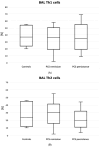Cytoimmunological Profile of Lower Airways in Post-COVID-19 Syndrome (PCS): Predictive Value of Bronchoalveolar Lavage
- PMID: 40429360
- PMCID: PMC12112653
- DOI: 10.3390/jcm14103361
Cytoimmunological Profile of Lower Airways in Post-COVID-19 Syndrome (PCS): Predictive Value of Bronchoalveolar Lavage
Abstract
Background: It has yet to be determined whether the immunocytological profile of the bronchoalveolar lavage (BAL) in respiratory post-COVID syndrome (PCS) reflects the risk of persistent interstitial lung disease (ILD), including pulmonary fibrosis. In this study, we aimed to assess the prognostic value of the BAL cytoimmunologic profile in PCS-related ILD. Materials and Methods: We enrolled 58 non-smoking patients with a history of COVID-19 and new-onset ILD, divided into PCS remission and PCS persistence groups based on clinical data, including repeated computed tomography and pulmonary function tests. We phenotyped BAL major T cell subsets, immune checkpoints (including programmed cell death-1, PD1), and markers of Th1/Th2/Th17 polarization. Results: The PCS groups compared to the control showed increased total cell, lymphocyte, and neutrophil counts and a high BAL neutrophil:lymphocyte ratio (NLR). PCS persistence compared to the controls presented an increased neutrophil count (26 [17-36] vs. 2.6 [1.9-5.4] 103/mL, median [Q1-Q3], p < 0.001) and percentage, BAL NLR (0.77 [0.26-1.63] vs. 0.21 [0.17-0.31], p < 0.0001), CD8+PD1+ cell percentage (43.5 [34-60.5] vs. 24.5 [22-44]%, p = 0.045), and a decreased CD4:CD8 ratio. A high percentage of CD4+CD196+CD183 cells (relevant to Th17 activity, 6.2 [2.0-9.4] vs. 1.2 [0.7-2.7]%, p = 0.02) and increased BAL supernatant elevated IL-8 levels (62.5 [16-243] vs. 10.9 [3.44-32] pg/mL, p = 0.002) were found in the PCS persistence vs. control groups. In the total PCS group, predicted values of Vital Capacity (VC) [16-243] and Diffusing Lung Capacity for CO (DLCO) correlated negatively with BAL NLR; VC correlated negatively with BAL CD8+PD1+; and DLCO correlated positively with the CD4:CD8 ratio. Conclusions: Worse prognosis in PCS is associated with higher BAL NLR, BAL neutrophilia, an elevated percentage of CD8+PD1+ lymphocytes, and a decline in the CD4:CD8 ratio. Th17 cells and IL-8 participate in lung PCS persistence.
Keywords: T exhausted cells; Th17 cells; bronchoalveolar lavage; interstitial lung disease; lung lymphocytes; lung neutrophils; post-COVID syndrome.
Conflict of interest statement
The authors declare that they have no competing interests.
Figures





Similar articles
-
Increased in CD8 T lymphocytes in the BAL fluid of patients with sulfur mustard gas-induced pulmonary fibrosis.Respir Med. 2007 Apr;101(4):786-92. doi: 10.1016/j.rmed.2006.08.003. Epub 2006 Sep 18. Respir Med. 2007. PMID: 16982181
-
[Cigarette smoking results in the number of CD8+Fas Ligand+ T cytotoxic lymphocytes in bronchoalveolar lavage (BAL) fluid of patients with idiopathic pulmonary fibrosis (IPF)].Przegl Lek. 2007;64(10):689-94. Przegl Lek. 2007. PMID: 18409287 Polish.
-
Evaluating the Diagnostic Value of Lymphocyte Subsets in Bronchoalveolar Lavage Fluid and Peripheral Blood Across Various Diffuse Interstitial Lung Disease Subtypes.Biomolecules. 2025 Jan 14;15(1):122. doi: 10.3390/biom15010122. Biomolecules. 2025. PMID: 39858516 Free PMC article.
-
[Deep lung--cellular reaction to HIV].Rev Port Pneumol. 2007 Mar-Apr;13(2):175-212. Rev Port Pneumol. 2007. PMID: 17492233 Review. Portuguese.
-
Bronchoalveolar Lavage Lymphocytes in the Diagnosis of Hypersensitivity Pneumonitis among Patients with Interstitial Lung Disease.Ann Am Thorac Soc. 2020 Nov;17(11):1455-1467. doi: 10.1513/AnnalsATS.202005-420OC. Ann Am Thorac Soc. 2020. PMID: 32757946
References
-
- World Health Organization COVID-19 Epidemiological Update—24 December 2024. [(accessed on 21 April 2025)]. Available online: https://www.who.int/publications/m/item/covid-19-epidemiological-update-....
-
- Fernandez-de-Las-Peñas C., Notarte K.I., Macasaet R., Velasco J.V., Catahay J.A., Ver A.T., Chung W., Valera-Calero J.A., Navarro-Santana M. Persistence of post-COVID symptoms in the general population two years after SARS-CoV-2 infection: A systematic review and meta-analysis. J. Infect. 2024;88:77–88. doi: 10.1016/j.jinf.2023.12.004. - DOI - PubMed
-
- Soriano J.B., Murthy S., Marshall J.C., Relan P., Diaz J.V. WHO Clinical Case Definition Working Group on Post-COVID-19 Condition. A clinical case definition of post-COVID-19 condition by a Delphi consensus. Lancet Infect. Dis. 2022;22:e102–e107. doi: 10.1016/S1473-3099(21)00703-9. - DOI - PMC - PubMed
Grants and funding
LinkOut - more resources
Full Text Sources
Research Materials

